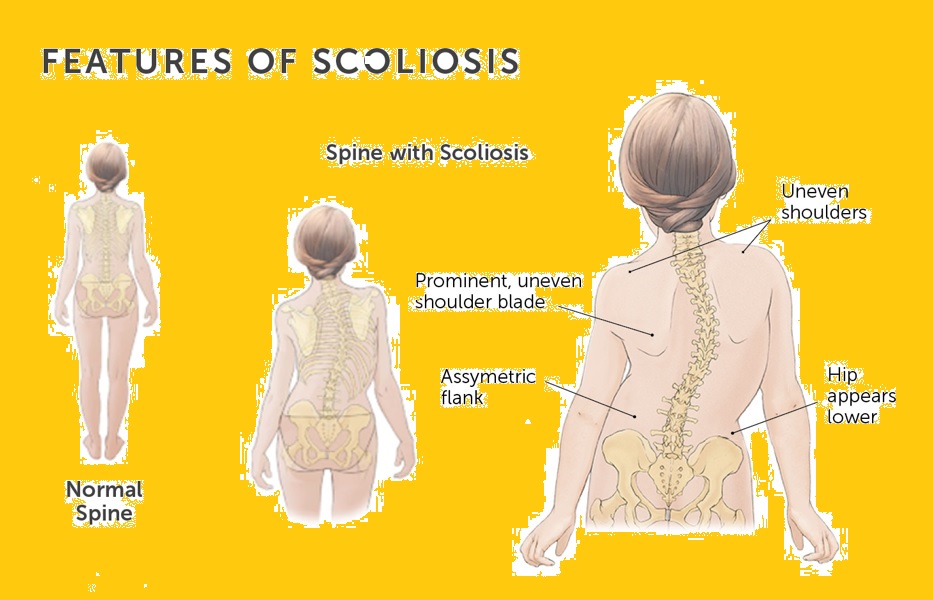What Is Scoliosis?
Scoliosis affects the spine. Although the spine is sometimes called “the backbone,” it’s not just one bone. It’s made of lots of small bones (called vertebrae) that are connected by a type of elastic tissue called cartilage. This gives people the flexibility to bend, stretch, balance, and even walk.
Scoliosis is when the vertebrae form a curved line instead of being straight. Sometimes they also rotate (twist), like a corkscrew. This can cause health problems.
Types of Scoliosis
Orthopedic specialists (doctors and other providers who treat bone and muscle problems) group scoliosis into types. Knowing the type of scoliosis helps health care providers treat it.
- Idiopathic scoliosis. This is the most common type of scoliosis. Kids can get it at any age, but most of the time it happens around puberty when a child goes through a growth spurt. Experts don’t know exactly why this type of scoliosis develops, but it runs in some families.
- Congenital scoliosis. This type of scoliosis happens when something goes wrong with the way some of the vertebrae developed while a baby was in the womb. The problem might not be noticed until a child goes through a growth spurt, usually around age 2 or between 8 and 13.
- Scoliosis caused by a medical condition. Some kids develop scoliosis because they have a long-term medical problem that affects the muscles or skeletal system. For example, kids with muscular dystrophy, cerebral palsy, Marfan syndrome, or osteogenesis imperfecta may get scoliosis. Kids who have had tumors or growths on their spine may also develop scoliosis.

Symptoms:
Because of the many possible combinations of curvatures, scoliosis can look different in different children.
- uneven shoulder heights
- head not centered with the rest of the body
- uneven hip heights or positions
- uneven shoulder blade heights or positions
- prominent shoulder blade
- when standing straight, uneven arm lengths
- when bending forward, the left and right sides of the back are asymmetrical
Symptoms that suggest scoliosis can resemble those of other spinal conditions or deformities, or may result from an injury or infection.
Causes:
There are several causes of abnormal spinal curves:
In many cases, as in idiopathic scoliosis, there’s no definite cause for (or way to prevent) the spine’s failure to grow as straight as it should. Some babies are born with spinal formation problems that cause the spine to grow unevenly. These include congenital scoliosis, congenital kyphosis, spina bifida or Klippel-Feil anomaly.
Some children have nerve or muscle (neuromuscular) diseases, injuries or other illnesses that cause spinal deformities, such as cerebral palsy, spina bifida or muscular dystrophy. In these conditions, muscle abnormalities combined with the child’s growth result in deformity.
Other causes of scoliosis may include:
- bone dysplasias: many generalized abnormalities of bone formation are associated with scoliosis
- connective tissue disorders: conditions with abnormal tissues and ligaments, such as Marfan syndrome and Ehlers-Danlos syndrome
- differences in leg lengths: mild leg length differences may cause a slight curvature but rarely cause a serious curvature
- spinal cord injury with paralysis
- infection
- tumors
Treatments
Small curves usually don’t cause problems. But a curve that gets worse can be bad for a person’s health. Very large curves can damage the joints and cause arthritis of the spine. Large curves can make the ribs rub against the pelvis, causing pain. Someone whose spine curves a lot might get lung problems.
If it looks like scoliosis could cause health problems, doctors(spine surgeons) will treat it with a back brace to prevent it from getting worse. In some cases, kids need surgery.

Post a comment